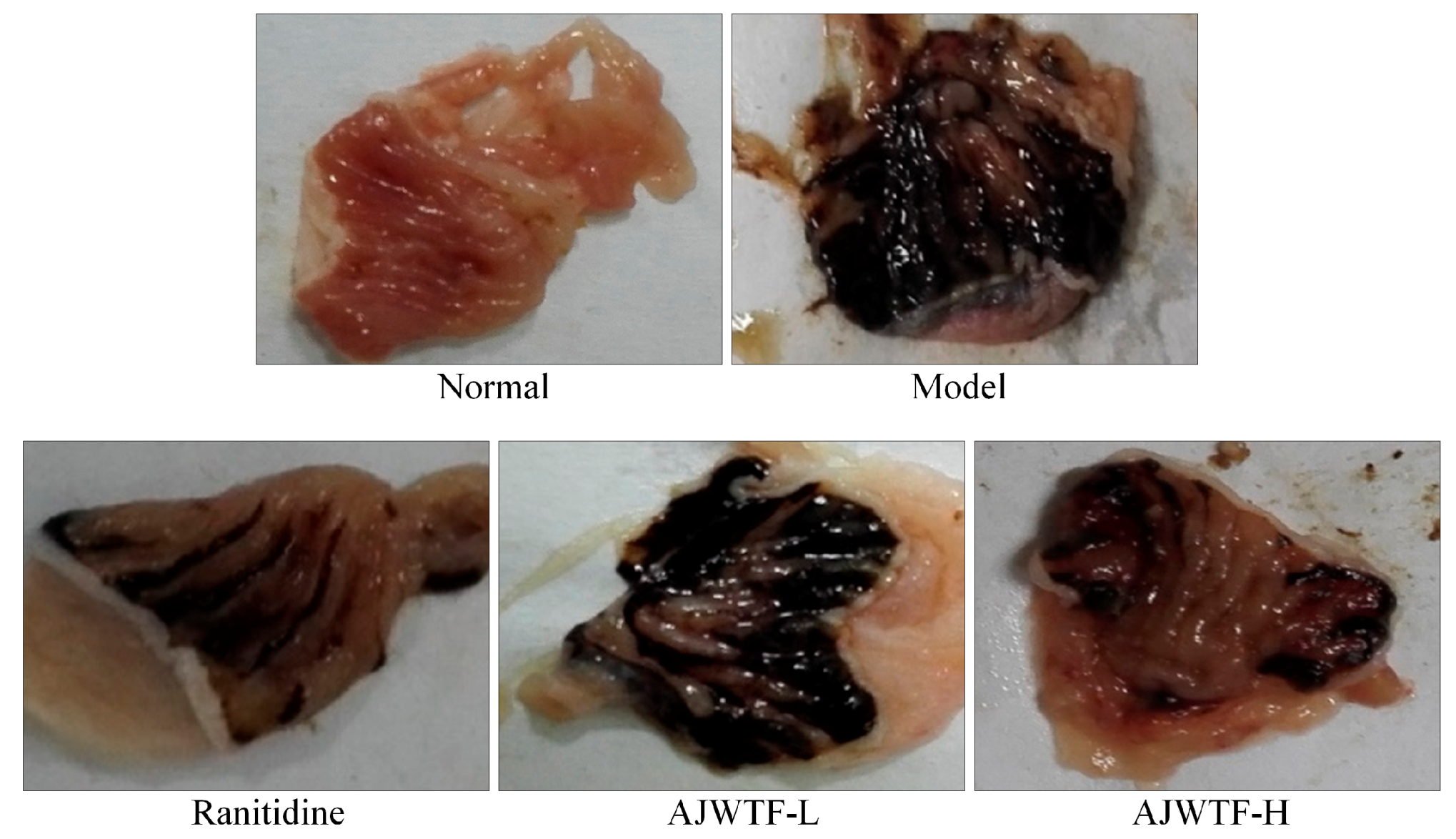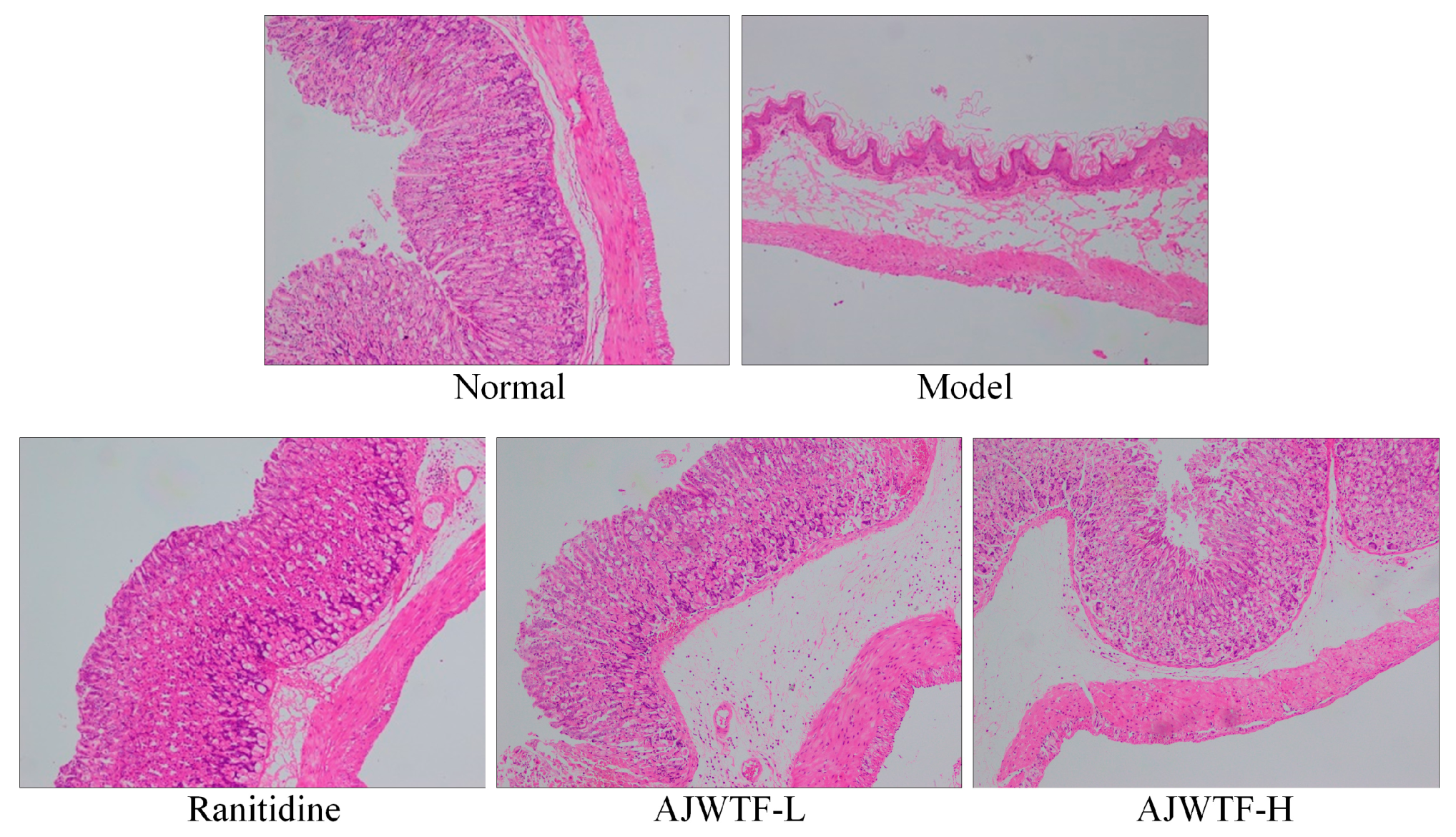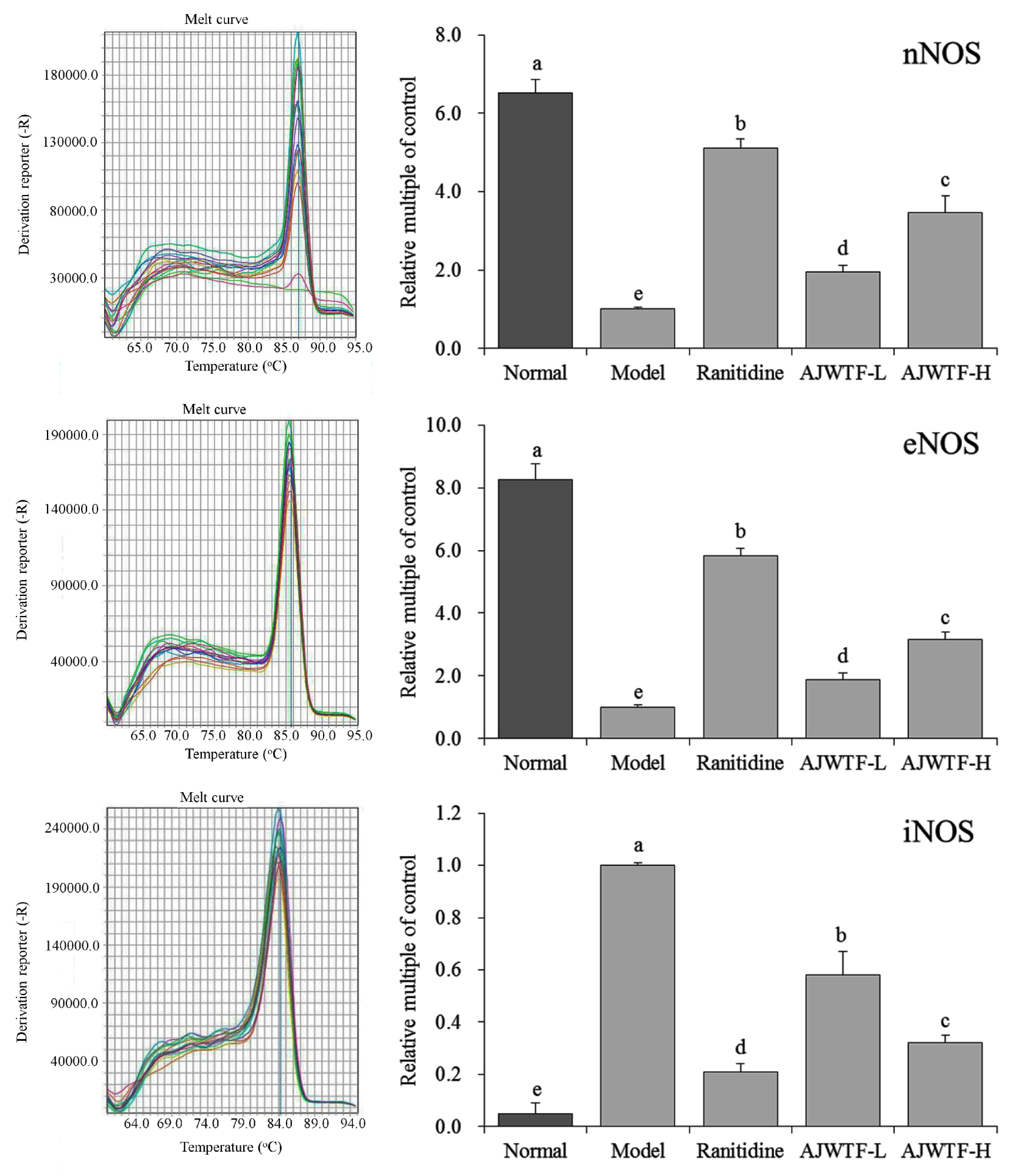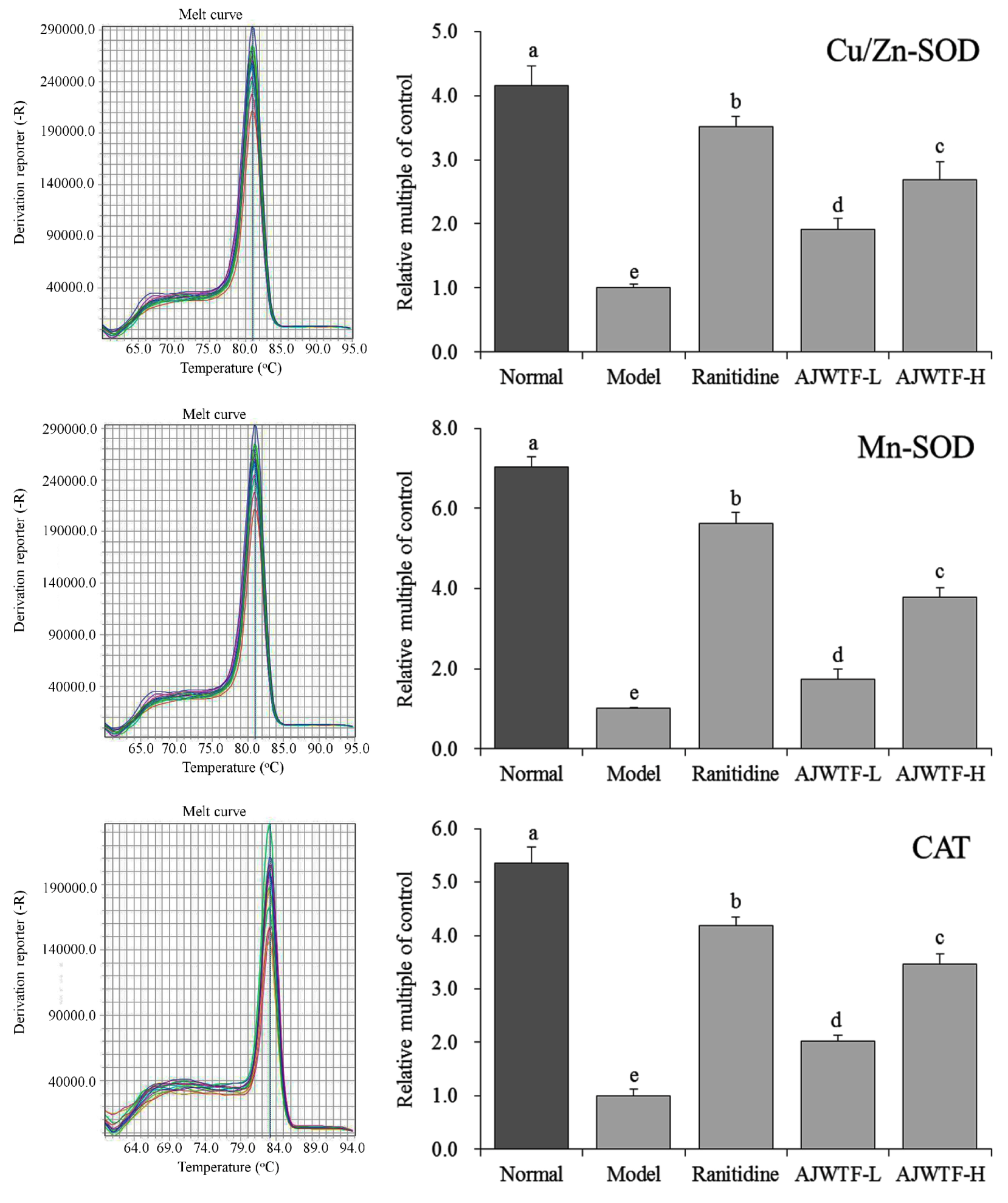Preventive Effect of Anji White Tea Flavonoids on Alcohol-Induced Gastric Injury through Their Antioxidant Effects in Kunming Mice
Abstract
1. Introduction
2. Materials and Methods
2.1. Extraction of Anji White Tea Flavonoids
2.2. Determination of Anji White Tea Flavonoid Content
2.3. Establishment of Alcohol-Induced Gastric Injury Model in Mice
2.4. Determination of Superoxide Dismutase and Glutathione Activities and Malondialdehyde Level in Serum
2.5. Determination of Superoxide Dismutase and Glutathione Activities and Malondialdehyde Level in Gastric Tissue
2.6. Pathological Observation of Gastric Tissue
2.7. Quantitative Polymerase Chain Reaction Assay
2.8. Statistical Analysis
3. Results
3.1. Content of Anji White Tea Flavonoid Extracts
3.2. Volume and pH of Gastric Juice in Mice
3.3. Gastric Damage Area and Inhibitory Rate of Anji White Tea Flavonoids in Mice
3.4. Pathological Observation of Gastric Tissue in Mice
3.5. Superoxide Dismutase and Glutathione Activities and Malondialdehyde Level in Mouse Serum and Gastric Tissues
3.6. Expression of nNOS, eNOS, and iNOS Messenger RNA in Gastric Tissue of Mice
3.7. Expression of Cu/Zn–Superoxide Dismutase, Mn–Superoxide Dismutase, and Catalase Messenger RNA in Gastric Tissues of Mice
4. Discussion
5. Conclusions
Author Contributions
Funding
Conflicts of Interest
References
- Zima, T.; Fialová, L.; Mestek, O.; Janebová, M.; Crkovská, J.; Malbohan, I.; Stípek, S.; Mikulíková, L.; Popov, P. Oxidative stress, metabolism of ethanol and alcohol-related diseases. J. Biomed. Sci. 2001, 8, 59–70. [Google Scholar] [CrossRef] [PubMed]
- Salim, A.S. Protection against stress-induced acute gastric mucosal injury by free radical scavengers. Intensive Care Med. 1991, 17, 455–460. [Google Scholar] [CrossRef] [PubMed]
- Chang, W.; Bai, J.; Tian, S.; Ma, M.; Li, W.; Yin, Y.; Deng, R.; Cui, J.; Li, J.; Wang, G.; Zhang, P.; Tao, K. Autophagy protects gastric mucosal epithelial cells from ethanol-induced oxidative damage via mTOR signaling pathway. Exp. Biol. Med. 2017, 242, 1025–1033. [Google Scholar] [CrossRef]
- Xu, L.; Shi, P.T.; Fu, X.S.; Cui, H.F.; Ye, Z.H.; Cai, C.B.; Yu, X.P. Protected geographical indication identification of a Chinese green tea (Anji-white) by near-infrared spectroscopy and chemometric class modeling techniques. J. Spectrosc. 2013, 2013, 1–8. [Google Scholar] [CrossRef]
- Kähkönen, M.P.; Heinonen, M. Antioxidant activity of anthocyanins and their aglycons. J. Agric. Food Chem. 2003, 51, 628–633. [Google Scholar] [CrossRef]
- Zhang, W.; Dong, Z.; Chang, X.; Zhang, C.; Rong, G.; Gao, X.; Zeng, Z.; Wang, C.; Chen, Y.; Rong, Y.; et al. Protective effect of the total flavonoids from Apocynum venetum L. on carbon tetrachloride-induced hepatotoxicity in vitro and in vivo. J. Physiol. Biochem. 2018, 74, 301–312. [Google Scholar] [CrossRef] [PubMed]
- Huang, A. Advances in research of pharmacological action of flavonoids. Auhui Agri. Sci. Bull. 2007, 13, 71–72. [Google Scholar]
- O’Reilly, J.D.; Mallet, A.I.; McAnlis, G.T.; Young, I.S.; Halliwell, B.; Sanders, T.A.; Wiseman, H. Consumption of flavonoids in onions and black tea: Lack of effect on F2-isoprostanes and autoantibodies to oxidized LDL in healthy humans. Am. J. Clin. Nutr. 2001, 73, 1040–1044. [Google Scholar] [CrossRef] [PubMed]
- Yoshida, H.; Ishikawa, T.; Hosoai, H.; Suzukawa, M.; Ayaori, M.; Hisada, T.; Sawada, S.; Yonemura, A.; Higashi, K.; Ito, T.; et al. Inhibitory effect of tea flavonoids on the ability of cells to oxidize low density lipoprotein. Biochem. Pharmacol. 1999, 58, 1695–1703. [Google Scholar] [CrossRef]
- Lee, H.L.; Kang, K.S. Protection effect of punicalagin isolated from pomegranate on inflammation and ethanol-induced gastric mucosal injury. Bull. Korean Chem. Soc. 2016, 37, 1778–1782. [Google Scholar] [CrossRef]
- Elshazly, S.M.; Abd El Motteleb, D.M.; Ibrahim, I.A. Hesperidin protects against stress induced gastric ulcer through regulation of peroxisome proliferator activator receptor gamma in diabetic rats. Chem. Biol. Int. 2018, 291, 153–161. [Google Scholar] [CrossRef] [PubMed]
- La Casa, C.; Villegas, I.; Alarcón de la Lastra, C.; Motilva, V.; Martín Calero, M.J. Evidence for protective and antioxidant properties of rutin, a natural flavone, against ethanol induced gastric lesions. J. Ethnopharmacol. 2000, 71, 45–53. [Google Scholar] [CrossRef]
- Lv, N.; Zhang, W.Z.; Chen, L.L.; Zhang, J.; Shen, M.H. Antioxidant activity of flavonoids from Anji white tea in vitro. J. Toxicol. 2014, 28, 389–392. [Google Scholar]
- Zhao, X.; Yi, R.; Sun, P.; Song, J. Improvement effects of Kuding tea flavonoids extracts on d-galactose induced mice aging. Sci. Technol. Food Ind. 2017, 38, 303–308. [Google Scholar] [CrossRef]
- Mathews, S.; Xu, M.; Wang, H.; Bertola, A.; Gao, B. Animals models of gastrointestinal and liver diseases. Animal models of alcohol-induced liver disease: Pathophysiology, translational relevance, and challenges. Am. J. Physiol. Gastrointest. Liver Physiol. 2014, 306, 819–823. [Google Scholar] [CrossRef] [PubMed]
- Yi, R.; Wang, R.; Sun, P.; Zhao, X. Antioxidant-mediated preventative effect of Dragon-pearl tea crude polyphenol extract on reserpine-induced gastric ulcers. Exp. Ther. Med. 2015, 10, 338–344. [Google Scholar] [CrossRef] [PubMed]
- Zhao, X.; Qian, Y.; Li, G.J.; Tan, J. Preventive effects of the polysaccharide of Larimichthys crocea swim bladder on carbon tetrachloride (CCl4)-induced hepatic damage. Chin. J. Nat. Med. 2015, 13, 521–528. [Google Scholar] [CrossRef]
- Madushani Herath, K.H.I.N.; Bing, S.J.; Cho, J.; Kim, A.; Kim, G.; Kim, J.S.; Kim, J.B.; Doh, Y.H.; Jee, Y. Sasa quelpaertensis leaves ameliorate alcohol-induced liver injury by attenuating oxidative stress in HepG2 cells and mice. Acta Histochem. 2018, 120, 477–489. [Google Scholar] [CrossRef]
- Suo, H.; Zhao, X.; Qian, Y.; Sun, P.; Zhu, K.; Li, J.; Sun, B. Lactobacillus fermentum Suo attenuates HCl/ethanol induced gastric injury in mice through its antioxidant effects. Nutrients 2016, 8, 155. [Google Scholar] [CrossRef]
- McDonough, K.H. Antioxidant nutrients and alcohol. Toxicology 2003, 189, 89–97. [Google Scholar] [CrossRef]
- Araújo Júnior, R.F.; Garcia, V.B.; Leitão, R.F.; Brito, G.A.; Miguel Ede, C.; Guedes, P.M.; de Araújo, A.A. Carvedilol improves inflammatory response, oxidative stress and fibrosis in the alcohol-induced liver injury in rats by regulating Kuppfer cells and hepatic stellate cells. PLoS ONE 2016, 12, e0148868. [Google Scholar] [CrossRef]
- Qian, Y.; Zhang, J.; Fu, X.; Yi, R.; Sun, P.; Zou, M.; Long, X.; Zhao, X. Preventive effect of raw Liubao tea polyphenols on mouse gastric injuries induced by HCl/ethanol via anti-oxidative stress. Molecules 2018, 23, 2848. [Google Scholar] [CrossRef] [PubMed]
- Ignarro, L.J.; Byrns, R.E.; Sumi, D.; de Nigris, F.; Napoli, C. Pomegranate juice protects nitric oxide against oxidative destruction and enhances the biological actions of nitric oxide. Nitric Oxide 2006, 15, 93–102. [Google Scholar] [CrossRef] [PubMed]
- Liu, H.B.; Huang, X.D.; Liu, M.H.; Shanguan, J.Y. Significance of NOS expressions in gastric carcinoma. Med. J. Nat. Defend. For. Northwest China 2002, 23, 115–117. [Google Scholar]
- Zhao, X.; Sun, P.; Li, G.; Yi, R.; Qian, Y.; Park, K.Y. Polyphenols in Kuding tea help prevent HCl/ethanol-induced gastric injury in mice. Food Funct. 2018, 9, 1713–1725. [Google Scholar] [CrossRef]
- Calatayud, S.; Ramírez, M.C.; Sanz, M.J.; Moreno, L.; Hernández, C.; Bosch, J.; Piqué, J.M.; Esplugues, J.V. Gastric mucosal resistance to acute injury in experimental portal hypertension. Br. J. Pharmacol. 2001, 132, 209–317. [Google Scholar] [CrossRef] [PubMed]
- Shore, R.; Björne, H.; Omoto, Y.; Siemiatkowska, A.; Gustafsson, J.A.; Lindblad, M.; Holm, L. Sex differences and effects of oestrogen in rat gastric mucosal defence. World J. Gastroenterol. 2017, 23, 426–436. [Google Scholar] [CrossRef]
- Banerjee, M.; Vats, P. Reactive metabolites and antioxidant gene polymorphisms in type 2 diabetes mellitus. Redox Biol. 2013, 2, 170–177. [Google Scholar] [CrossRef] [PubMed]
- Gottfredsen, R.H.; Larsen, U.G.; Enghild, J.J.; Petersen, S.V. Hydrogen peroxide induce modifications of human extracellular superoxide dismutase that results in enzyme inhibition. Redox Biol. 2013, 1, 24–31. [Google Scholar] [CrossRef]
- Chen, S.; Zhao, X.; Sun, P.; Qian, J.; Shi, Y.; Wang, R. Preventive effect of Gardenia jasminoides on HCl/ethanol induced gastric injury in mice. J. Pharmacol. Sci. 2017, 133, 1–8. [Google Scholar] [CrossRef]
- Ighodaro, O.M.; Akinloye, O.A. First line defence antioxidants-superoxide dismutase (SOD), catalase (CAT) and glutathione peroxidase (GPX): Their fundamental role in the entire antioxidant defence grid. Alex. J. Med. 2018, 54, 287–293. [Google Scholar] [CrossRef]
- Kuo, K.L.; Weng, M.S.; Chiang, C.T.; Tsai, Y.J.; Lin-Shiau, S.Y.; Lin, J.K. Comparative studies on the hypolipidemic and growth suppressive effects of oolong, black, pu-erh, and green tea leaves in rats. J. Agric. Food Chem. 2005, 53, 480–489. [Google Scholar] [CrossRef] [PubMed]
- Wong, J.Y.; Abdulla, M.A.; Raman, J.; Phan, C.W.; Kuppusamy, U.R.; Golbabapour, S.; Sabaratnam, V. Gastroprotective effects of Lion’s mane mushroom Hericium erinaceus (Bull.:Fr.) Pers. (Aphyllophoromycetideae) extract against ethanol-induced ulcer in rats. Evid. Based Complement. Altern. Med. 2013, 2013, 492976. [Google Scholar] [CrossRef]
- Bonthius, D.J., Jr.; Winters, Z.; Karacay, B.; Bousquet, S.L.; Bonthius, D.J. Importance of genetics in fetal alcohol effects: Null mutation of the nNOS gene worsens alcohol-induced cerebellar neuronal losses and behavioral deficits. Neurotoxicology 2015, 46, 60–72. [Google Scholar] [CrossRef]
- Wu, X.; Huang, Q.; Xu, N.; Cai, J.; Luo, D.; Zhang, Q.; Su, Z.; Gao, C.; Liu, Y. Antioxidative and anti-inflammatory effects of water extract of Acrostichum aureum Linn. against ethanol-induced gastric ulcer in rats. Evid. Based Complement. Altern. Med. 2018, 2018, 3585394. [Google Scholar] [CrossRef]
- Morin, M.P.; Bedran, T.B.; Fournier-Larente, J.; Haas, B.; Azelmat, J.; Grenier, D. Green tea extract and its major constituent epigallocatechin-3-gallate inhibit growth and halitosis-related properties of Solobacterium moorei. BMC Complement. Altern. Med. 2015, 15, 48. [Google Scholar] [CrossRef] [PubMed]
- Pillai, S.; Oresajo, C.; Hayward, J. Ultraviolet radiation and skin aging: Roles of reactive oxygen species, inflammation and protease activation, and strategies for prevention of inflammation-induced matrix degradation—A review. Int. J. Cosmet. Sci. 2005, 27, 17–34. [Google Scholar] [CrossRef] [PubMed]
- Olaleye, M.T.; Akinmoladun, A.C. Comparative gastroprotective effect of post-treatment with low doses of rutin and cimetidine in rats. Fundam. Clin. Pharmacol. 2013, 27, 138–145. [Google Scholar] [CrossRef] [PubMed]
- Liu, Y.; Gou, L.; Fu, X.; Li, S.; Lan, N.; Yin, X. Protective effect of rutin against acute gastric mucosal lesions induced by ischemia-reperfusion. Pharm. Biol. 2013, 51, 914–919. [Google Scholar] [CrossRef]




| Gene Name | Sequence |
|---|---|
| nNOS | Forward: 5’-GAATACCAGCCTGATCCATGGAA-3’ |
| Reverse: 5’-TCCTCCAGGAGGGTGTCCACCGCATG-3’ | |
| eNOS | Forward: 5’-TCAGCCATCACAGTGTTCCC-3’ |
| Reverse: 5’-ATAGCCCGCATAGCGTATCAG-3’ | |
| iNOS | Forward: 5’-GTTCTCAGCCCAACAATACAAGA-3’ |
| Reverse: 5’-GTGGACGGGTCGATGTCAC-3’ | |
| Cu/Zn–SOD | Forward: 5′-AACCAGTTGTGTTGTCAGGAC-3′ |
| Reverse: 5′-CCACCATGTTTCTTAGAGTGAGG-3′ | |
| Mn–SOD | Forward: 5’-CAGACCTGCCTTACGACTATGG-3’ |
| Reverse: 5’-CTCGGTGGCGTTGAGATTGTT-3’ | |
| CAT | Forward: 5’-GGAGGCGGGAACCCAATAG-3’ |
| Reverse: 5’-GTGTGCCATCTCGTCAGTGAA-3’ | |
| GAPDH | Forward: 5’-AGGTCGGTGTGAACGGATTTG-3’ |
| Reverse: 5’-GGGGTCGTTGATGGCAACA-3’ |
| Group | Gastric Juice Volume (mL) | Gastric Juice pH |
|---|---|---|
| Normal | 0.01 ± 0.01 b | 3.90 ± 0.17 a |
| Model | 0.22 ± 0.03 a | 1.91 ± 0.11 d |
| Ranitidine | 0.13 ± 0.03 ab | 2.52 ± 0.12 b |
| AJWTF-L | 0.19 ± 0.04 ab | 2.10 ± 0.15 c |
| AJWTF-H | 0.15 ± 0.02 ab | 2.31 ± 0.14 bc |
| Group | Area of Gastric Injury (mm2) | Inhibitory Rate of Gastric Injury (%) |
|---|---|---|
| Normal | 0.00 ± 0.00 e | 100 ± 0.00 a |
| Model | 20.56 ± 5.29 a | - |
| Ranitidine | 1.98 ± 0.62 d | 90.37 ± 5.86 b |
| AJWTF–L | 13.44 ± 1.57 b | 34.63 ± 3.48 d |
| AJWTF–H | 3.76 ± 1.65 c | 81.71 ± 2.12 c |
| Group | SOD (U/mL) | GSH (mg/L) | MDA (nmol/mL) |
|---|---|---|---|
| Normal | 155.595 ± 3.669 a | 19.112 ± 0.890 a | 6.000 ± 0.003 c |
| Model | 61.732 ± 11.933 e | 8.8789 ± 0.261 e | 10.667 ± 1.670 a |
| Ranitidine | 137.679 ± 8.663 b | 18.209 ± 0.987 b | 6.444 ± 1.031 ab |
| AJWTF–L | 95.032 ± 7.944 d | 10.233 ± 0.952 d | 9.222 ± 0.956 a |
| AJWTF–H | 113.532 ± 18.779 ac | 13.243 ± 0.426 c | 7.556 ± 0.685 ab |
| Group | SOD (U/mg protein) | GSH (mg/g protein) | MDA (nmol/mg protein) |
|---|---|---|---|
| Normal | 62.42 ± 2.880 a | 10.106 ± 0.184 a | 0.460 ± 0.069 d |
| Model | 30.17 ± 0.820 | 3.956 ± 0.577 d | 0.753 ± 0.059 a |
| Ranitidine | 60.42 ± 2.220 a | 9.232 ± 0.913 a | 0.486 ± 0.059 cd |
| AJWTF–L | 40.33 ± 2.260 c | 6.196 ± 0.752 c | 0.691 ± 0.040 b |
| AJWTF–H | 52.11 ± 3.780 b | 8.119 ± 0.773 b | 0.582 ± 0.065 c |
© 2019 by the authors. Licensee MDPI, Basel, Switzerland. This article is an open access article distributed under the terms and conditions of the Creative Commons Attribution (CC BY) license (http://creativecommons.org/licenses/by/4.0/).
Share and Cite
Liu, B.; Feng, X.; Zhang, J.; Wei, Y.; Zhao, X. Preventive Effect of Anji White Tea Flavonoids on Alcohol-Induced Gastric Injury through Their Antioxidant Effects in Kunming Mice. Biomolecules 2019, 9, 137. https://doi.org/10.3390/biom9040137
Liu B, Feng X, Zhang J, Wei Y, Zhao X. Preventive Effect of Anji White Tea Flavonoids on Alcohol-Induced Gastric Injury through Their Antioxidant Effects in Kunming Mice. Biomolecules. 2019; 9(4):137. https://doi.org/10.3390/biom9040137
Chicago/Turabian StyleLiu, Bihui, Xingxing Feng, Jing Zhang, Yang Wei, and Xin Zhao. 2019. "Preventive Effect of Anji White Tea Flavonoids on Alcohol-Induced Gastric Injury through Their Antioxidant Effects in Kunming Mice" Biomolecules 9, no. 4: 137. https://doi.org/10.3390/biom9040137
APA StyleLiu, B., Feng, X., Zhang, J., Wei, Y., & Zhao, X. (2019). Preventive Effect of Anji White Tea Flavonoids on Alcohol-Induced Gastric Injury through Their Antioxidant Effects in Kunming Mice. Biomolecules, 9(4), 137. https://doi.org/10.3390/biom9040137





